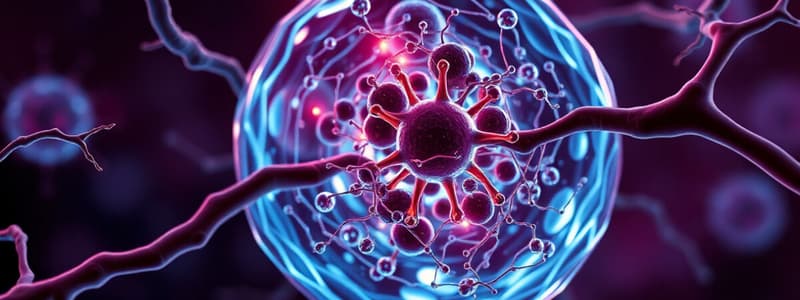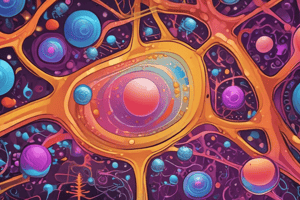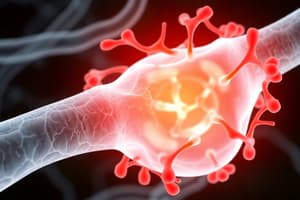Podcast
Questions and Answers
Which of the following processes are NOT involved in maintaining cellular homeostasis?
Which of the following processes are NOT involved in maintaining cellular homeostasis?
- Oxidative phosphorylation
- Protein ubiquitination
- Autophagy
- Photosynthesis (correct)
Disruptions in cellular homeostasis can only lead to cellular stress.
Disruptions in cellular homeostasis can only lead to cellular stress.
False (B)
What is the primary function of oxidative phosphorylation?
What is the primary function of oxidative phosphorylation?
To generate ATP, the main energy source for cells.
The ______ is the powerhouse of the cell where oxidative phosphorylation takes place.
The ______ is the powerhouse of the cell where oxidative phosphorylation takes place.
Match the following molecules with their roles in oxidative phosphorylation:
Match the following molecules with their roles in oxidative phosphorylation:
The electron transport chain in oxidative phosphorylation uses the energy released from electron movement to create a proton gradient.
The electron transport chain in oxidative phosphorylation uses the energy released from electron movement to create a proton gradient.
What is the final product of oxidative phosphorylation?
What is the final product of oxidative phosphorylation?
Which of the following processes provides high-energy molecules (NADH and FADH2) that fuel the electron transport chain in oxidative phosphorylation?
Which of the following processes provides high-energy molecules (NADH and FADH2) that fuel the electron transport chain in oxidative phosphorylation?
Which of the following proteins is NOT directly involved in the TRAIL-mediated apoptotic pathway?
Which of the following proteins is NOT directly involved in the TRAIL-mediated apoptotic pathway?
Activation of mTOR promotes autophagy.
Activation of mTOR promotes autophagy.
What is the role of tBID in the TRAIL-induced apoptosis pathway?
What is the role of tBID in the TRAIL-induced apoptosis pathway?
Apoptosis, a type of programmed cell death, involves the release of cellular contents.
Apoptosis, a type of programmed cell death, involves the release of cellular contents.
The flat, membrane-bound structure involved in autophagosome formation is called the ______ or ______ membrane.
The flat, membrane-bound structure involved in autophagosome formation is called the ______ or ______ membrane.
What is the primary function of Granzyme-B in cytotoxic T lymphocyte (CTL) mediated apoptosis?
What is the primary function of Granzyme-B in cytotoxic T lymphocyte (CTL) mediated apoptosis?
The binding of the ______ complex on antigen-presenting cells (APCs) to the ______ complex on T-cells initiates the process of T-cell activation.
The binding of the ______ complex on antigen-presenting cells (APCs) to the ______ complex on T-cells initiates the process of T-cell activation.
Match the signaling pathways with their effect on autophagy regulation:
Match the signaling pathways with their effect on autophagy regulation:
What are the two primary sources of intracellular free calcium (Ca2+) during T-cell activation?
What are the two primary sources of intracellular free calcium (Ca2+) during T-cell activation?
Which of the following is NOT a type of autophagy?
Which of the following is NOT a type of autophagy?
Match the following molecules with their respective roles in T-cell activation:
Match the following molecules with their respective roles in T-cell activation:
Autophagy is only activated during nutrient deprivation.
Autophagy is only activated during nutrient deprivation.
Which of the following events directly results from the activation of PLC-γ1 during T-cell activation?
Which of the following events directly results from the activation of PLC-γ1 during T-cell activation?
What is the main advantage of apoptosis in eliminating infected cells?
What is the main advantage of apoptosis in eliminating infected cells?
The activity of the IP3 receptor (IP3R) is reduced during the early phase of T-cell activation by the tyrosine kinase Fyn.
The activity of the IP3 receptor (IP3R) is reduced during the early phase of T-cell activation by the tyrosine kinase Fyn.
The truncated form of BID, known as ______, is a key substrate cleaved by Granzyme-B, triggering the effector caspase cascade.
The truncated form of BID, known as ______, is a key substrate cleaved by Granzyme-B, triggering the effector caspase cascade.
Which of the following is NOT a direct consequence of elevated intracellular Ca2+ levels in T-cells?
Which of the following is NOT a direct consequence of elevated intracellular Ca2+ levels in T-cells?
What is the final electron acceptor in the electron transport chain (ETC)?
What is the final electron acceptor in the electron transport chain (ETC)?
Disruptions in the oxidative phosphorylation pathway do not impact ATP production.
Disruptions in the oxidative phosphorylation pathway do not impact ATP production.
Name one condition that can result from a deficiency in ATP production.
Name one condition that can result from a deficiency in ATP production.
During oxidative phosphorylation, protons flow through ATP synthase to convert ADP and inorganic __________ into ATP.
During oxidative phosphorylation, protons flow through ATP synthase to convert ADP and inorganic __________ into ATP.
Match the following cellular processes with their functions:
Match the following cellular processes with their functions:
What effect can increased production of reactive oxygen species (ROS) have on cells?
What effect can increased production of reactive oxygen species (ROS) have on cells?
Autophagy only occurs in response to periods of nutrient abundance.
Autophagy only occurs in response to periods of nutrient abundance.
What physiological role does autophagy play in the cell?
What physiological role does autophagy play in the cell?
A deficiency in ATP production may lead to __________ weakness and exercise intolerance.
A deficiency in ATP production may lead to __________ weakness and exercise intolerance.
What is one consequence of damaged proteins accumulating in the cell?
What is one consequence of damaged proteins accumulating in the cell?
What is the role of calmodulin in the activation of T-cells?
What is the role of calmodulin in the activation of T-cells?
The death receptor family is part of the tumor necrosis factor receptor superfamily.
The death receptor family is part of the tumor necrosis factor receptor superfamily.
What are the two types of death receptor signaling complexes?
What are the two types of death receptor signaling complexes?
Upon TCR signaling, activated calmodulin binds to ______, releasing it from MEF2D.
Upon TCR signaling, activated calmodulin binds to ______, releasing it from MEF2D.
Which of the following factors can trigger apoptosis?
Which of the following factors can trigger apoptosis?
Match the following death receptors with their alternate names:
Match the following death receptors with their alternate names:
All three receptors that recruit death-inducing signaling complexes (DISCs) have identical compositions.
All three receptors that recruit death-inducing signaling complexes (DISCs) have identical compositions.
What is the primary role of caspase-8 in the apoptotic signaling cascade?
What is the primary role of caspase-8 in the apoptotic signaling cascade?
The ______ signaling complex is formed at the FAS receptor, TRAILR1 or TRAILR2.
The ______ signaling complex is formed at the FAS receptor, TRAILR1 or TRAILR2.
Which of the following is NOT a member of the death receptor family?
Which of the following is NOT a member of the death receptor family?
Flashcards
Cellular Homeostasis
Cellular Homeostasis
The maintenance of stable conditions in cells for proper function and survival.
Importance of Homeostasis
Importance of Homeostasis
Essential for optimal metabolic function, growth, and survival of cells.
Autophagy
Autophagy
A cellular process that removes damaged organelles to maintain homeostasis.
Oxidative Phosphorylation (OXPHOS)
Oxidative Phosphorylation (OXPHOS)
Signup and view all the flashcards
Electron Transport Chain (ETC)
Electron Transport Chain (ETC)
Signup and view all the flashcards
Proton Gradient
Proton Gradient
Signup and view all the flashcards
NADH and FADH2
NADH and FADH2
Signup and view all the flashcards
ATP Synthase
ATP Synthase
Signup and view all the flashcards
ATP Synthesis
ATP Synthesis
Signup and view all the flashcards
Final Electron Acceptor
Final Electron Acceptor
Signup and view all the flashcards
Mitochondrial Myopathies
Mitochondrial Myopathies
Signup and view all the flashcards
Reactive Oxygen Species (ROS)
Reactive Oxygen Species (ROS)
Signup and view all the flashcards
Cellular Cleanup
Cellular Cleanup
Signup and view all the flashcards
Recycling in Cells
Recycling in Cells
Signup and view all the flashcards
Quality Control Mechanisms
Quality Control Mechanisms
Signup and view all the flashcards
Stress Response in Autophagy
Stress Response in Autophagy
Signup and view all the flashcards
TRAIL and TRAILR
TRAIL and TRAILR
Signup and view all the flashcards
Caspase 8
Caspase 8
Signup and view all the flashcards
Cytochrome c (cytoC)
Cytochrome c (cytoC)
Signup and view all the flashcards
APAF1
APAF1
Signup and view all the flashcards
mTOR
mTOR
Signup and view all the flashcards
ULK1 complex
ULK1 complex
Signup and view all the flashcards
Types of autophagy
Types of autophagy
Signup and view all the flashcards
MEF2D in T-Cells
MEF2D in T-Cells
Signup and view all the flashcards
Calmodulin Function
Calmodulin Function
Signup and view all the flashcards
Nur77 Transcription Regulation
Nur77 Transcription Regulation
Signup and view all the flashcards
Apoptosis Trigger Factors
Apoptosis Trigger Factors
Signup and view all the flashcards
Death Receptor (DR) Family
Death Receptor (DR) Family
Signup and view all the flashcards
TNFR1
TNFR1
Signup and view all the flashcards
FAS Receptor
FAS Receptor
Signup and view all the flashcards
Death-Inducing Signaling Complexes (DISCs)
Death-Inducing Signaling Complexes (DISCs)
Signup and view all the flashcards
TRAIL Receptors
TRAIL Receptors
Signup and view all the flashcards
Granzyme-B
Granzyme-B
Signup and view all the flashcards
tBID
tBID
Signup and view all the flashcards
Effector Caspase Cascade
Effector Caspase Cascade
Signup and view all the flashcards
Phagocytes
Phagocytes
Signup and view all the flashcards
Calcium (Ca2+) in T-cells
Calcium (Ca2+) in T-cells
Signup and view all the flashcards
TCR-CD3 Complex
TCR-CD3 Complex
Signup and view all the flashcards
PLC-γ1
PLC-γ1
Signup and view all the flashcards
DAG and IP3
DAG and IP3
Signup and view all the flashcards
Intracellular free Ca2+
Intracellular free Ca2+
Signup and view all the flashcards
IP3R/ITPR
IP3R/ITPR
Signup and view all the flashcards




